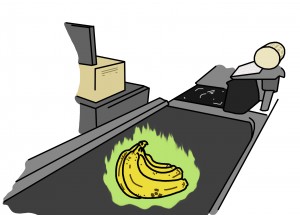It has been labeled by www.globalresearch.ca as the “greatest short-term threat to humanity.” With such a powerful statement, we should clearly be alarmed. Yet most people would not be able to guess what it refers to. This statement refers to the fact that the Fukushima nuclear power plant continues to spill radiation into the Pacific Ocean. More specifically, it is the spent fuel pools, or piles of spent nuclear fuel rods, that has scientists and government officials most worried. It is a story that most people have heard about to some extent, primarily the initial collapse of the plant as a result of the 2011 earthquake and tsunami, but the severity of the danger is largely kept under wraps and underreported. Of more urgent concern is the effect that the radiation leak could have on imported food from the Pacific in our restaurants and grocery stores. But first, some background information about the situation is needed.
The pools, combined with 1,534 spent fuel rods, are just sitting there, waiting to erupt and cause mass devastation at the slightest tremor. In fact, David Suzuki says that if there is an earthquake of seven or above on the Richter scale, the entire building could come down, and the likelihood of an earthquake of that magnitude occurring in the next three years is 95 per cent. If these pools catch fire or collapse, it is thought that radiation could reach North America within days.

It is a vast problem, with so many what-ifs and different things to be cautious about. For the record, the Japanese nuclear agency has begun the process of safely removing the rods. This is a very fragile and dangerous process, with a very small margin of error. But there is nothing that can be done about it for now. It is just a case of waiting and hoping for the best. But the safety of our food is of immediate concern. It does not take a nuclear scientist to know that radiation mixed with food equals bad news, and it is important to know that Canadians can be confident in the safety of imported fish and other food.
With a reported 300 tonnes of contaminated water pouring into the sea every day, it is understandable that so many people across the nation are swearing off fish. However, thus far the news from various food safety agencies is that there are no traces of radiation in fish being consumed in North America. Furthermore, while scientists say that the radiation will reach the west coast of North America by early next year, the World Health Organization has stated that the radiation particles will have a very minimal effect on our health. The WHO has said that concentrations will be below their safety levels. Suzuki, in a report he published in October 2013, says these low levels are the result of complex currents and whirlpools off the Japanese coast continuing to dilute the levels of radiation, and directing the radiation particles back to the coast. He said this pattern should continue for two decades.
This assurance has also been echoed by the U.S. Food and Drug Administration. As of September 2013, the FDA, in a report on their website, have stated that there is no evidence that radiation particles “from the Fukushima incident are present in the U.S. food supply at levels that would pose a public health concern.” This is true for both FDA-regulated food products imported from Japan and U.S. domestic food products, including seafood caught off the coast of the United States. The FDA has advised consumers not to alter their consumption of sea food.
This does not mean that there is no danger at all, though. Fish off the Japanese coast are found to be infected with cesium-134, a radioactive isotope, and fisheries in Japan remain closed. Add this to the growing concerns about more radiation being released, and there is definitely cause for caution. However, the WHO and FDA remain adamant that the infected fish are not being brought to North America.
Going forward, Suzuki says a cautious approach should be applied by Canadians: it is ok to keep fish a part of our diet, so long as it is caught locally and sustainably. It is also fair to believe that fish caught from the Pacific West Coast is safe, especially as long as food safety organizations say it is. However, it is always better to be safe than sorry.




